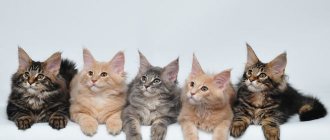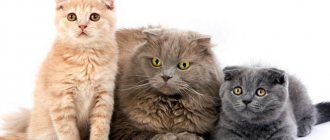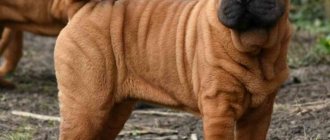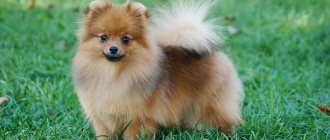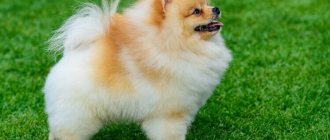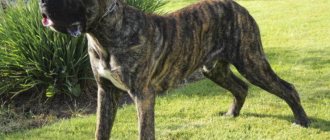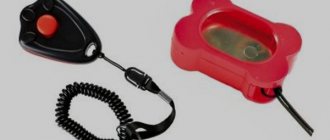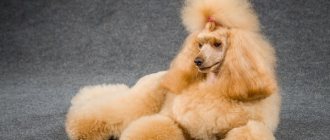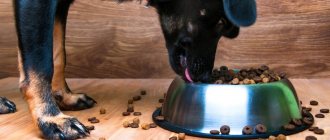Today it’s hard to believe, but until the 70s, terriers were only one color - black and tan. This traditional color was explained by the fact that the ancestors of our breed were English Toys, and in this country, as you know, they approach everything, even the color of domestic animals, very conservatively.
However, over time, it was the opportunity to diversify the breed that won out among breeders, and now dogs of this species come in a variety of varieties - from pure white to blue with various shades and combinations, beige, black and white and others.
Two pigments (black and yellow) and as many as 10 genes are involved in the formation of color in toys, so there can be many options for their interaction. So what color are representatives of this breed?
Description of the breed
The Toy Terrier comes in two varieties: long-haired and short-haired. The dogs' height does not exceed 28 cm, they weigh no more than 3 kg.
Known for being listed in the Guinness Book of Records as the dog with the smallest weight - 681 g.
Toy has high legs, thin bones and lean muscles. The back is straight, the withers are not very pronounced. The head is miniature, the body is square, the muzzle is pointed. The nose is either black or matches the color of the coat. The toy's bite should be correct, the teeth should be even and small. The baby's eyes are wide apart, with tight-fitting eyelids. They are dark and round. The ears are triangular in shape and large. The auricle is quite open.
Toy terriers hold their tail up. Puppies have their tails docked down to 2-3 vertebrae. Representatives of the long-haired breed have a tail decorated with long feathering. The Smooth-haired Toy Terrier has a short coat. In long-haired animals, the body is covered in places with wavy hair, its length ranges from 3 to 5 cm.
The color features of the Toy Terrier are associated with the breed standard. They have desirable, undesirable and unacceptable colors. The former include black and tan, blue and tan, brown and tan, lilac and tan, red, cream and fawn. The following colors are acceptable: blue, brown, black, lilac, saddleback. According to the standard, wool with white spots, as well as brindle, piebald and marbled, are unacceptable.
What does the standard look like?
A breed standard is traits, a set of characteristics that are inherent in all types of individuals of a certain breed of dog, which allow us to judge the purebred of an individual dog.
The following standards exist for the Toy Terrier breed:
- the dog is distinguished by its elegance and graceful, lean physique;
- a prominent forehead, expressive eyes and erect, pointed ears are characteristic features of the breed;
- parallel hind legs, set wider than the front legs. Small and neat front paws;
- representatives of the breed are aristocratic in movement, have a short stride;
- thin, low-set tail;
- in the classic version, the toy terrier is a short-haired dog, but there are also long-haired individuals, as a rule, their hair is wavy and there is a distinctive fringe on the ears;
- Color brown-chocolate tones or black and tan.
Character
By nature, these dogs are kind, affectionate, cheerful, energetic and, as their owners note, self-confident. A toy can easily attack a much larger dog if it needs to protect its owner. Toy Terriers do not notice that they are miniature and always show courage. The cowardly nature of representatives of this breed is considered a deviation from the norm.
These babies are distinguished by intelligence, intelligence and, if necessary, cunning. Toy can notify about the appearance of strangers in the apartment by loud barking. He loves to play with his own people and remembers commands easily. If you raise it from an early age, the pet will not cause any problems to its owner. Training brings good results, but you should not yell at a toy during training.
It is not recommended to own a toy terrier for people who have small children in their family. These dogs have thin bones and are easily injured during active play. Children aged 6-7 years and older understand responsibility for a dog and can calmly care for a small pet.
The peculiarity of the character of these dogs is that they cannot stand loneliness. When left without its owner for a long time, the puppy may even cry. Therefore, people who are absent from work should not get toy terriers.
Types by coat type
According to the type of coat, all toy terriers are divided into two large groups - smooth-haired and long-haired. As a rule, Russian Toys have long-haired representatives.
Smooth-haired
Today this is the most common and popular type and does not require additional care for the cover.
The fur of representatives of the species is short, but thick, dense, evenly distributed over the body. The cover is velvety with a noble tint.
Longhair
The length of the fur of these individuals reaches up to 5 cm. A distinctive feature is also the presence of fringe on the ears, which gives them a special charm. The muzzle area and the front parts of the paws are covered with short hair.
There is a variety of colors of this type:
- black;
- chocolate;
- ginger;
- platinum.
Types of breed
Today there are two main types of toy terriers: English and Russian. Russian was developed much later than English, but it is much more popular among modern dog breeders. The English Toy Terrier is currently on the verge of extinction.
English toy terrier
The English Toy Terrier looks like a copy of the Manchester Terrier. These are agile, smart and brave dogs, infinitely devoted to their owners. The number of representatives of the English Toys has approached a critical level. In connection with this, the English Kennel Club is taking measures to preserve the gene pool of the breed.
English toy terriers reach a height of 30 cm and a weight of 4 kg. The head is narrow, the transition to the muzzle is moderately expressed. The dogs' bite is correct. Their eyes are almond-shaped, the cut is slightly oblique. The back is slightly arched. The chest is deep and narrow. The tail is set low and should not be below the hocks. The English Toy is allowed only black and tan color. The coat is thick and short.
Representatives of this breed are easy to train. But education must begin from the first days the puppy appears in the house. When teaching commands, you should not shout at your pet, this scares him. Dogs of this species are always active and inquisitive. In a house where there is a small one, a positive mood is guaranteed.
Russian toy terrier
The Russian Toy Terrier was bred in Moscow in 1958. Therefore, its second name is Moscow Toy Terrier. The dog's height reaches 30 cm, weight reaches 2.5 kg. The characteristic features of the Russian Toy are a light head, the transition to the muzzle is sharply defined. The eyes are round, slightly protruding. The ears are sharp, large, erect. The nose is black or the color of the fur on the body. The back is straight, the muscles are dry. The limbs are long and straight, the tail is docked. According to the type of coat, dogs are either smooth-haired or long-haired. The latter have funny feathers on their ears and paws. The Russian Terrier is smart, has an excellent memory and a lively character. The pet will try to exploit the owner if he is not educated. Gets along well with children and pets.
Toy terrier mini
The first representatives of mini toy terriers appeared at the end of the 20th century. Since then, interest in tiny dogs has only increased. Their small height and weight can be both advantages and disadvantages for keeping at home. There is no separate breed standard for Mini Toy Terriers. The general standard states that mini toy terriers include those representatives of the breed whose height is less than 20 cm and whose weight does not exceed 1.5 kg. The dwarf terrier grows up to 2 years.
Mini Toys also come in long-haired and short-haired varieties. Caring for the former is complicated by the need for daily combing of the coat. For smooth-haired dogs, it is enough to carry out this procedure at least once a month.
The downside of tiny terriers is their bad temperament. They become attached only to their owner, and are indifferent to other family members. It is not recommended to leave them with small children, as in response to the child’s advances they may bite him. If you start training from a very early age and teach the rules of behavior, your pet's character can be friendly and calm. To prevent the mini dog from being angry and aggressive, it is not recommended to leave it at home alone.
Life expectancy and health
Russian Toy Terriers live on average up to 10-15 years . Life expectancy often depends on the quality of the dog's care. Toys have a remarkable ability to quickly recover from illness.
To improve health you need:
- active walks in the fresh air. If the dog does not exercise enough, joint diseases may develop;
- warm clothes and shoes for the pet to prevent hypothermia;
- the need to remember the fragile structure of the toy. Jumping from heights should not be allowed;
- correct diet. Salt and spices, sausage and sweets should be prohibited. It is necessary to take care of vitamins. Do not overfeed;
- regular visits to the veterinarian.
They are not insured against eye diseases.
Most common:
- cataract.
- progressive retinal atrophy.
Maintenance and care
Caring for a toy terrier does not cause much trouble. The little dog feels great in an apartment and quickly learns to use the litter box. She doesn't need long walks. If you can’t take him for a walk, you can replace the walk with active games.
A toy terrier needs to be bathed once a month, keeping its ears protected from water. It is also necessary to brush the coat regularly. Toy terriers shed twice a year, but in apartment living conditions, where the air is dry and warm, dogs lose hair all year round. Once a month, your pet’s nails should be trimmed, otherwise they may grow crooked and cause discomfort to the dog. This is done using a nail clipper, and the sharp ends are smoothed with a special nail file. Once a week, brush your teeth with it using a toothbrush or attachment.
You can feed your pet both prepared premium food and natural food. The main requirement is balance and moderation. You cannot include fatty, smoked and spicy foods, as well as sweets and grapes in your toy terrier’s menu.
Nutrition
The diet of a toy terrier must be balanced and contain the necessary vitamins and microelements. Products that can be given to your Russian Toy:
- meat, 50-60 g per day - lamb, beef, beef by-products, chicken;
- lean fish, 1 yolk (no more than once a week);
- fresh vegetables: cucumbers, zucchini, carrots, cabbage, peppers, beets;
- porridge: buckwheat, rice;
- fermented milk products: fermented baked milk, kefir cottage cheese;
- fruits: apples, pears, bananas, peaches, apricots.
With natural nutrition, it is necessary to supplement your pet’s food with vitamins and microelements. You can make a table of the required additives in advance.
Pet stores offer a wide range of concentrated dry food and canned food for dogs. For a small pet, choose a product that is appropriate for its weight and age.
Good nutrition is the key to a toy terrier’s well-being.
Diseases
The weakest points of toys are bones, teeth, digestive tract and eyes. Often they have to pull out baby teeth when the molars are already growing. These dogs also suffer from tartar, which causes tooth loss.
Small dogs often experience digestive disorders. These include diarrhea, the cause of which can be anything: allergies, poisoning, helminthiasis or infection. If diarrhea appears, the dog should not be fed all day; it only needs to be given water frequently. The next day you can feed with dietary products: boiled chicken, oatmeal. If your pet has bloody diarrhea or lethargy, you should immediately consult a veterinarian.
Health problems in toy dogs are often genetically determined. These include conjunctivitis. Your pet's eyes become watery and pus accumulates in them. The disease occurs against a background of weak immunity. Over time, small dogs develop vision problems. They may develop cataracts or retinal atrophy.
Toy terriers suffer from allergies. Dogs are allergic to certain foods, dander from other animals, dog cosmetics, or insect bites. It manifests itself with the following symptoms:
- the dog begins to carefully lick itself or rub against pieces of furniture, trying to relieve the itching;
- the skin peels off and dermatitis appears.
Allergies can be treated with antihistamines, but it is better to start treatment after consulting a doctor.
Toy owners note that toys often tremble all over their bodies. This is a physiological feature of the breed – an easily excitable nervous system. Dogs tremble when scared, when they want to go to the toilet, when they are lacking attention, or when they are cold. However, shaking can be a symptom of a serious illness, so you should contact your veterinarian to determine the cause of the fever. Over time, the dog owner can learn to determine why the pet is trembling.
If the dog was not purchased for breeding, it can be neutered. Castration will help avoid many problems:
- character becomes calmer;
- there will be no unpleasant smell from dog marks in the apartment;
- life expectancy increases;
- the risk of hormonal diseases is reduced.
If you provide dogs with good care, timely examinations and vaccinations, toy terriers live more than 20 years.
Color
Previously, the only acceptable color was black and tan, and this continued until the mid-twentieth century. However, in the seventies, brown and red creatures began to be allowed into exhibitions, after which other original colors appeared. The skin of puppies is formed due to two pigments. This gives many different combinations.
The standard allows for the existence of all tan colors and any red shades. As a rule, tan marks are located above the eyes, on the chest, on the muzzle, and on the paws. They are also found under the ponytail, on the inside of the thighs. It is important that they are bright and clear.
The richer the better. Disadvantages include light marks on the chest and toes, large markings, and too dark markings. Dark, brown, blue color is also considered a disadvantage. White individuals, those who have such spots on the abdomen and on the head, are not allowed to compete. Large spots on the chest and neck are considered a disqualifying fault.
White
Unfortunately, such representatives of the breed are not allowed to compete. They do not participate in exhibitions and do not produce offspring that will someday receive an award.
However, they are very cute, their hair is soft and smooth to the touch. If you like such pets, you do not plan to win prizes, and perhaps you want to spay or neuter the dog, then why worry about whether the standard allows such colors? Feel free to have a baby like this!
You will have to take a little more care of this type of fur than standard fur, because it gets dirty quickly and needs to be cleaned more often. But this is not a big problem, because owners often prefer to walk their pets in clothes that prevent dirt from getting onto their fur coat.
To read: Secrets of proper nutrition for Bengal cats and kittens: what is healthy to feed and what is strictly prohibited?
Ginger
Essentially, this is the same as fawn coloring. There are both light and bright variations of red skin.
Such dogs have an albinism gene, which makes the main pigments lighter.
This is one of the most common palettes; fiery terriers look very stylish, they are noticeable from afar, and stand out from others. It is desirable that the tone be very saturated; pale ones are also allowed, but are rated much lower.
Pearl
This is another name for cream color. More often, pearl babies appear in both light-colored parents, because the gene for this color is recessive.
Occasionally it happens that cream offspring are born from standard mothers and fathers who have hidden genes. These dogs have real aristocracy; they look attractive and elegant.
However, they need to be carefully looked after, because a light fur coat gets dirty faster and requires regular cleaning to maintain its aesthetics.
Sable
Sable dogs are those in which every hair is red on the roots and charcoal on the tips. As a rule, in childhood they are completely dark, but over time the hair at the roots lightens. If the baby was born already sable, you should be afraid that over the years he will become completely red. In some cases, the coal one remains only on the back or on the ears, and the fiery one dominates. This is a popular color, such terriers can be found everywhere, they correspond to the standard and are very popular.
Blue
Rare four-legged animals that look truly original. The same recessive gene is responsible for this fur coat color, which makes it less saturated.
It blurs the colors, as if brightening the skin. The gene initially went to a black kitten, it lightened its natural tone, and it was born gray-blue, and the brown one was born red-blue.
Such four-legged animals are called lilac ones. It seems that the fur of these animals is painted with watercolors, it looks so delicate and transparent. Let's say they have a tan. These are very expensive and valuable specimens; many people try to breed just such toys. They are slightly more expensive than standard ones.
Nicknames of toy terriers
A cute and funny pet usually gets a corresponding cute nickname. You can name a boy a toy terrier taking into account one of the following factors:
- small size dogs: Funtik, Malysh, Krosh;
- cheerful character of the pet: Shumok, Volcano, Energizer.
Nicknames for girls are selected according to the same principle, but in such a way that they emphasize the elegance and grace of a small dog: Barbie, Bead, Doll, Lady, Princess, Jasmine.
Sometimes the owners approach this issue with humor, then tiny Tyson, Thunder, Giant or Yula, Tyapa, Knopochka rush around the apartment.
Training
As you know, almost all terriers are very stubborn. This does not mean that they are difficult to raise, just that the process of training them should be approached more easily. Remember, training your toy terrier will bear fruit if you don't show him any slack.
When communicating with a dog, you need to demonstrate your authority to him, but in no case with physical force. Some dogs of this breed refuse to follow even simple commands due to stubbornness.
In this case, you need to attract their attention with something interesting. The classic way is to demonstrate the presence of a treat that the dog will receive after successfully completing all tasks.
But this method has a negative side. Your dog may refuse to obey in the future if you don't want to give him a treat. It is important to be patient here, then a positive result will certainly come. There are situations in which a toy terrier will never follow commands. Let's list them:
Each of these situations will greatly affect your Toy Terrier's mood. When he is in a sad state, forcing him to do anything is an ineffective task. But, despite these problems, representatives of this breed are smart and savvy. They are easy to learn, especially traditional dog commands such as “down.” Step-by-step instructions for teaching a toy terrier commands:
This manipulation should be carried out several times a day for a week. Perhaps by day 4-5, the toy terrier will independently carry out the command, without your prompts. The dog should also be taught to go to the bed.
For this, the “place” command will be useful. Every dog living with its owner in the house should know it. Important! Never use physical force when training your Toy Terrier.
How to choose a puppy - price
To purchase a toy terrier puppy, you should contact a reliable nursery (Solnyshko Aleksi, Zvezda Dona, Rossiyskiy Tsled). When purchasing, be sure to check for a passport with a vaccination mark. Having bought a small puppy, you can start raising it from an early age. But at the same time, the owner receives a lot of additional troubles: changing baby teeth, spending on vaccinations, and others. The best option is to buy a teenage puppy that is already litter box trained, vaccinated and relatively independent.
The price of puppies depends on their origin. Babies that can be exhibited cost about 80,000 rubles. The price of ordinary long-haired puppies in different cities of Russia varies from 10,000 to 37,000 rubles. Smooth-haired and mini toy terrier puppies cost up to 25,000 rubles.
Kennels also offer mestizos - a cross between a Chihuahua and a toy terrier. This dog is not inferior in quality to any of these breeds. They are just as sociable and friendly, and are easy to train.
Distinctive features
Russian Toys are very active small decorative dogs.:
- Weight – up to 3 kg
- Height at withers – up to 28 cm
The dog is very lively, playful, jumping. Affectionate and loyal, always protects the owner. A funny creature that can give you many fun minutes.
Toys are overexcitable, which results in almost constant trembling. The lack of undercoat makes them susceptible to even mild cold. For walks in unfavorable times of the year, the animal needs warm clothes.
Despite its miniature size, the animal is not a toy; it must be handled, taught from an early age to the norms of behavior, so that both the pet and the owner can live comfortably.
Lilac Toys shed differently than puppies of classic colors . The puppies look moth-eaten. The experience of breeders suggests that the use of antifungal shampoos can improve the appearance of babies.
You should also include vitamins in your diet. In toys, the time of molting coincides with the transition period, the so-called immune pit, when there is a sharp drop in immunity.
But even if you do nothing, the molting will go away by itself, you just need to be patient and not panic in vain.
Advantages and disadvantages of the breed
Like any other dog breed, the terrier has its pros and cons:
| Advantages | Flaws | |
| Doesn't need much physical activity, just a walk and active games. | Hair falls out constantly. | |
| He is easy to train and remembers commands easily. | Cannot stand loneliness and is not suitable for working people. | |
| Gets along well with children. | Small size does not allow the pet to show its watchdog and security qualities in full force. | |
| Easy to keep in apartment conditions. | Loves to bark for any reason. | |
| A brave dog beyond his size, ready to protect his owner from any danger. | Susceptible to hereditary diseases. | |
Toy terriers are amazing and cute creatures, despite their miniature nature, they have a strong-willed character. By making due efforts to raise a puppy, a person can find a faithful four-legged companion in it.
Common features
All the main types of toy terriers have one thing in common - they are small decorative “pocket” dogs that are exclusively a companion and friend to humans. Suitable for living in warmth and comfort, at home.
IMPORTANT!
During the cold season, all tois must be worn when going outside.
Common features are also:
- thin slender legs;
- compact body with a strong and straight back;
- active, playful character;
- obedient animal, trainable, undemanding;
- loyal to the owner, can warn of danger;
- friendly, but can show aggression when strangers appear and are treated rudely;
- fragile, like all dwarf dogs, needs constant attention.
Characteristic
Toy terriers are distinguished by the following features:
- their height is twenty-five to thirty centimeters, as a rule, females are smaller than males;
- weight ranges from one to three kilograms. Adult animals of greater or lesser weight are considered rejects. Some sellers offer dwarf toys, but most often these are sick and underfed dogs;
- the neck is long, the head is wedge-shaped, the skull is round, and the forehead is wide. The nose can be black or brown;
- scissor bite. The ears are set high and triangular;
- eyes dark, round;
- the life expectancy of these pets is twelve to fifteen years, it depends on the care, genetics and health of the dog;
- the coat can be smooth or long, in the first case the hair is more frequent and dense, in the second the fur can be wavy or straight, the ears are beautifully drooping.
The movements of such animals are impetuous, vigorous, they are full of energy and sometimes somewhat clumsy, but mostly very dexterous and fast. They love to wag their tail, bark loudly and jump.
Choosing and purchasing a pet
If you want to raise a dog for yourself, you should choose a puppy or a teenager. Even if you do not plan to participate in exhibitions or breed, it is better to contact a specialized nursery.
When purchasing a dwarf animal from your own hands or on the market, without a pedigree, there is a risk of it having diseases, differences from the standard, and admixtures of foreign blood.
Regardless of the purpose of purchase, it is best to buy a puppy from a kennel
Responsible breeders do not hand over the puppy to the owners until the litter is registered at 1.5 months. Usually by this time the kids are toilet and leash trained, vaccinated, and their character is clear.
Prices for small toys vary even within the same litter.
The following factors increase them:
- high class (show, breeding) and availability of documents for participation in exhibitions and breeding;
- parents have championship titles;
- female;
- long wool;
- rare color;
- small size.
A pet class baby can be purchased for about 5-15 thousand rubles, a breed class baby for 20-40 thousand rubles, a show class baby for 45-65 thousand rubles.
When choosing a Torus terrier, you should pay attention to its healthy appearance, cleanliness, mobility and sociability. Puppies must be kept in a clean room, and their parents must be well-groomed. If you plan to participate in exhibitions, you also need to check the puppy for compliance with the breed standard and study the pedigree.
There are kennels engaged in breeding toy terriers in many cities of Russia. So, Tiyanna, Blueberry Knights, Bravo Heat are known in Moscow. In St. Petersburg - From KO'Marina's pack, From the harem. In Yekaterinburg - BlagoDar.
